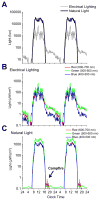Circadian Entrainment to the Natural Light-Dark Cycle across Seasons and the Weekend
- PMID: 28162893
- PMCID: PMC5335920
- DOI: 10.1016/j.cub.2016.12.041
Circadian Entrainment to the Natural Light-Dark Cycle across Seasons and the Weekend
Abstract
Reduced exposure to daytime sunlight and increased exposure to electrical lighting at night leads to late circadian and sleep timing [1-3]. We have previously shown that exposure to a natural summer 14 hr 40 min:9 hr 20 min light-dark cycle entrains the human circadian clock to solar time, such that the internal biological night begins near sunset and ends near sunrise [1]. Here we show that the beginning of the biological night and sleep occur earlier after a week's exposure to a natural winter 9 hr 20 min:14 hr 40 min light-dark cycle as compared to the modern electrical lighting environment. Further, we find that the human circadian clock is sensitive to seasonal changes in the natural light-dark cycle, showing an expansion of the biological night in winter compared to summer, akin to that seen in non-humans [4-8]. We also show that circadian and sleep timing occur earlier after spending a weekend camping in a summer 14 hr 39 min:9 hr 21 min natural light-dark cycle compared to a typical weekend in the modern environment. Weekend exposure to natural light was sufficient to achieve ∼69% of the shift in circadian timing we previously reported after a week's exposure to natural light [1]. These findings provide evidence that the human circadian clock adapts to seasonal changes in the natural light-dark cycle and is timed later in the modern environment in both winter and summer. Further, we demonstrate that earlier circadian timing can be rapidly achieved through natural light exposure during a weekend spent camping.
Keywords: advance; circadian phase; delay; non-visual; photoperiod; physiology; scotophase; spectral; spectrum; wavelength.
Copyright © 2017 Elsevier Ltd. All rights reserved.
Figures




Comment in
-
Circadian Rhythms: The Price of Electric Light.Curr Biol. 2017 Feb 20;27(4):R144-R145. doi: 10.1016/j.cub.2017.01.014. Curr Biol. 2017. PMID: 28222291
References
-
- Brainard GC, Petterborg LJ, Richardson BA, Reiter RJ. Pineal melatonin in syrian hamsters: circadian and seasonal rhythms in animals maintained under laboratory and natural conditions. Neuroendocrinol. 1982;35:342–348. - PubMed
-
- Carr AJ, Johnston JD, Semikhodskii AG, Nolan T, Cagampang FR, Stirland JA, Loudon AS. Photoperiod differentially regulates circadian oscillators in central and peripheral tissues of the Syrian hamster. Curr Biol. 2003;13:1543–1548. - PubMed
MeSH terms
Grants and funding
LinkOut - more resources
Full Text Sources
Other Literature Sources

